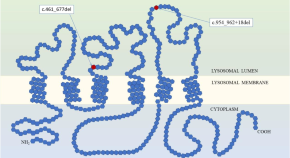Deterioration of visual quality and acuity as the first sign of ceroid lipofuscinosis type 3 (CLN3), a rare neurometabolic disease
Authors (first, second and last of 8)

Collection
Lysosomal storage diseases (LSD) are a group of inherited metabolic disorders caused by mutations of genes encoding lysosomal proteins involved in degradation of macromolecules. Thus, incompletely degraded macromolecules accumulate in lysosomes leading to dysfunctions of these organelles, which subsequently damages cells, tissues, and organs. LSD are severe conditions that significantly decrease the life span of affected individuals. Although LDS are monogenic diseases, they are characterized by intricate pathomechanisms leading to specific symptoms in patients. Most LSDs cause dysfunctions of the central nervous system (CNS), and this group of disorders is referred to as “neuronopathic LSD”.
In this Special Issue, Rajan and Escolar (2022) present an excellent overview of the currently available therapies for neuronopathic LSDs and suggest investigations towards strategies to prevent the development of CNS dysfunctions and/or to improve the function of affected CNS. One of the most impeding aspects is the delivery of drugs through the blood-brain-barrier (BBB). This problem is discussed in Sato et al. (2022), who review BBB properties in the context of developing therapeutic treatments.
Clinical observations and findings are crucial for understanding how genetic mutations influence phenotypes of patients. Kılavuz et al. (2022) describe a novel variant of the glucocerebrosidase (GBA) gene in a neuronopathic form of Gaucher disease type 2. This paper also emphasizes the significance of effective early diagnostic methods in the management of patients. Another important clinical work on glutaric aciduria type 1 is presented by Özgedik et al. (2022). Again, the importance of advanced diagnostic tests is underlined especially in symptomatic patients.
The importance of complex analyses of cellular mechanisms is demonstrated by Corrêa et al. (2022) who identified candidate genes and pathways leading to defective neural circuit formation that might contribute to cognitive impairment in mucopolysaccharidosis type II. Moreover, this study supports the existence of common pathogenic mechanisms in various neurodegenerative diseases. This subject is further discussed in the final article by Lai et al. (2022) describing how dysregulation of the endosomal-lysosomal system contributes to the pathogenesis of Alzheimer’s disease. This, in turn, buttresses the contention that understanding of lysosomal function might facilitate development of novel therapeutic approaches for the treatment of not only neuronopathic LSD but also other neurodegenerative diseases.
Finally, Purzycka-Olewiecka et al. (2022) indicated that the deterioration of visual quality and acuity might be the first clinical sign of ceroid lipofuscinosis type 3 (CLN3). This neurodegenerative lysosomal disease is characterized by progressive visual loss, epilepsy, and dementia, however, impaired vision was not reported previously as the first clinical demonstration. The authors proposed that CLN3 should be considered among patients with blindness of unknown cause which might improve diagnosis in such cases.
In summary, this special issue provides an important information about our current understanding of LSDs with neuronopathic component. It summarizes current therapeutical possibilities, underlines the importance of effective diagnostic procedures, and suggests novel approaches to study the underscoring molecular mechanisms.
Professor Grzegorz Węgrzyn, MS, PhD, DSc is the Chair of Department of Molecular Biology, University of Gdansk, Poland. His research focus is on the regulation of gene expression and DNA replication as well as on the mechanisms and new treatments of human genetic diseases. He has published over 400 scientific articles. Dr. Węgrzyn is a Deputy-Chief-Editor of Metabolic Brain Disease.





